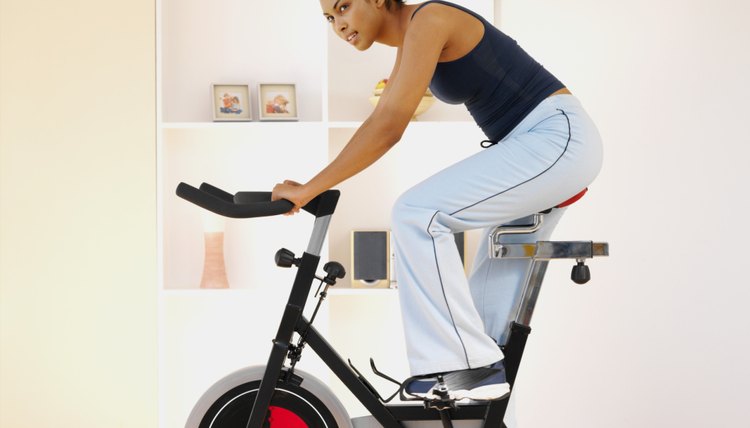What Are the Proper Seat Heights for an Exercise Bike?

Adjusting your exercise bike seat height is vital to reduce injury risk and increase performance. Seat adjustments are different for upright models versus recumbent bikes. Proper seat height should take into account your height, any medical issues you may have and your preferred riding position. Take the time to adjust the seat height at home and at the gym. If you are uncertain about making adjustments, refer to the machine's instruction manual or talk to a personal trainer.
Uprights
When you stand next to your upright bike, the seat should be level with the top of your hips. Seat yourself on the upright bike and make any adjustments to allow for a slight bend in your knees when you are at the end of a pedal stroke. While seated and with pedals level, adjust your seat forward or backward to line up your knee with the center of the front pedal. On an upright bike you can choose to sit straight up or lean forward. To prevent back strain, avoid leaning too far back while riding.
Recumbents
Recumbent bikes require fewer seat height adjustments, allowing you to move the seat forward or backward. Some bikes may allow for the seat to be angled at approximately 45 degrees, which is preferable to a horizontal setting. Your knees should not dip below hip level. Maintain a slight bend in the knees, up to 15 degrees, when your legs are extended the farthest at the bottom of the pedal stroke.
Handlebars
Adjusting your seat height on an upright bike requires you to properly align the bike’s handlebars. Ideally, the handlebar height should be aligned with the position of your bike seat, placing you in a slightly forward-leaning position, but the bars can be adjusted to your personal preference. Handlebars positioned too high may cause muscle strain while handlebars that are too low may lead to lower back issues and muscle fatigue.
Cautions
Incorrect seat positioning can cause perineal numbness, which if left untreated can lead to male erectile dysfunction. In a 2003 study published in "Medicine and Science in Sports and Exercise," researchers found that wider bike saddle seats tilted downward helped relieve stress on the cyclist’s perineal area, though the differences in seat models should be taken into consideration when adjusting. If you experience numbness, pain or any other symptoms while riding an exercise bike, promptly consult your doctor.
References
- Ride Fit: Correctly Adjusting Your Stationary Bike
- Spine-Health: Exercise Bike Setup and Precautions
- Hruska Clinic: Healthy Biking Hints
- American College of Sports Medicine: Selecting and Effectively Using Stationary Bicycles
- Medicine and Science in Sports and Exercise: The Effect of Saddle Design on Stresses in the Perineum During Cycling
Writer Bio
Joy Johnston has been an online journalist since 2005. She has served as senior producer for the health news website Sharecare and as a digital producer for the "Atlanta Journal-Constitution," where she helped develop the health channel. Johnston has also covered ways to stay fit in Atlanta.
